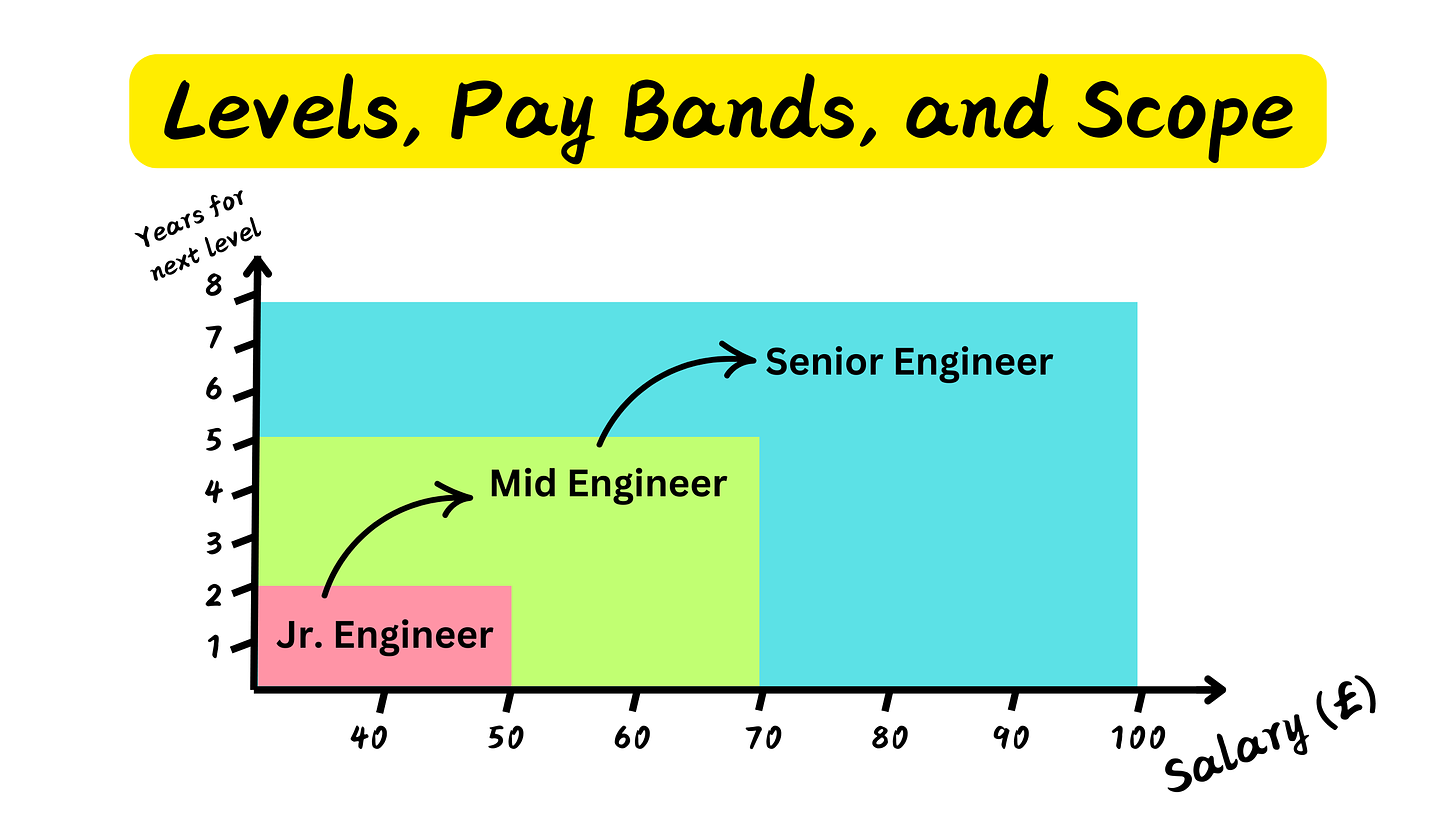Pay Bands, Scope of Influence, and Growth Timelines
Mapping engineering career growth through pay bands, influence, and progression timelines.
Audio version of this article using AI:
DISCLAIMER
The salary ranges mentioned in this article are example values meant to illustrate trends in pay progression across engineering levels. Actual compensation varies greatly depending on factors such as location, industry, company size, and economic conditions.
Additionally, the timeframes provided here are not prerequisites but rather indicative estimates of how long progression could take for each level. Your experience may differ based on individual performance, opportunities, and organizational structures.
How Does an Engineer Level Up?
Engineering careers expand not just vertically but also in terms of scope, responsibility, and pay. This progression can sometimes feel ambiguous, so understanding typical patterns of growth can help both engineers and managers set clearer expectations.
This article explores the growth of engineers through three major levels: junior, mid-level, and senior, with an emphasis on:
Pay bands (example ranges)
Scope of influence
Timeframes for progression
By clarifying these elements, managers can design effective career ladders, and engineers can navigate their growth more effectively.
Junior Engineers
Example Pay Band Range:
£40,000 – £50,000 (actual numbers vary by location, industry, and market conditions)
Junior engineers often start in a tighter pay band due to their narrower scope of influence and limited experience.
Scope of Influence:
Task-Level Focus
At this stage, junior engineers work on well-scoped tasks, such as implementing small features or fixing bugs. Their impact is largely limited to individual deliverables assigned by senior engineers or team leads.
Time to Progress:
1–2 years
The transition from junior to mid-level is relatively fast because the primary goal is to establish competence. By building strong foundational skills, engineers can quickly move on to larger responsibilities.
Key Characteristics:
Heavy reliance on mentorship and supervision.
Focus on learning workflows, debugging, and clean coding practices.
Contributions are narrowly scoped, such as completing a single pull request or solving isolated problems.
Room for mistakes as part of the learning process.
Tip for Managers:
Provide structured mentorship and assign projects that gradually increase in complexity to help junior engineers build confidence and independence.
Mid-Level Engineers
Example Pay Band Range:
£50,000 – £70,000 (actual numbers vary by location, industry, and market conditions)
The pay band widens at this level to account for differing expertise and the increased variability in impact.
Scope of Influence:
Team-Level Focus
Mid-level engineers operate at the team level, taking ownership of significant features or subsystems. They work independently, mentor junior engineers, and contribute to the team’s overall technical direction.
Time to Progress:
3–4 years
The progression to senior-level roles takes longer as it requires deeper technical expertise, strong ownership of outcomes, and a demonstrated ability to lead and mentor others effectively.
Key Characteristics:
Ownership: Mid-level engineers lead projects or features from start to finish, ensuring quality and timely delivery.
Mentorship: They guide junior engineers, helping them grow and reducing team bottlenecks.
Problem Solvers: They tackle moderately complex challenges, such as integrating new technologies.
Team Players: Collaboration with designers, product managers, and stakeholders is a regular part of their role.
Tip for Managers:
Mid-level engineers thrive with autonomy but still benefit from mentorship opportunities. Encourage them to take on leadership roles within projects to prepare for senior-level responsibilities.
Senior Engineers
Example Pay Band Range:
£70,000 – £100,000 (actual numbers vary by location, industry, and market conditions)
The pay band for senior engineers is even broader, reflecting the diversity in responsibilities, the high variance in impact at this level, and the room for growth within the level.
Scope of Influence:
Team Leadership
Senior engineers provide leadership within their own team. They mentor peers, set technical standards, and drive the success of complex projects. While their influence is significant, it is primarily concentrated within the boundaries of their immediate team.
Time to Progress:
5–8 years
Moving to the next step (Staff Engineer) requires a broader scope of influence, typically extending beyond a single team. This makes the transition longer and more challenging.
Key Characteristics:
Project Ownership: Senior engineers lead large, complex projects and ensure their successful delivery.
Technical Mentorship: They help junior and mid-level engineers grow, reducing bottlenecks and raising the technical bar for the team.
Team Leadership: Senior engineers take an active role in planning, decision-making, and fostering collaboration within their team.
Problem-Solving: They handle high-complexity challenges, ensuring the team navigates technical hurdles effectively.
Tip for Managers:
Encourage senior engineers to step into team leadership roles like project management, planning, and mentorship. Prepare them for eventual cross-team influence by involving them in organization-wide discussions.
At the same time, it is important to note that Senior Engineers need to carve their own path, identify opportunities for themselves and work with you on execution.
Useful links
📂 Get my 50 Engineering Manager Notion Templates to streamline hiring, onboarding, team management, and more!
🎉 CodeCrafters helps you become a better Software Engineer using my favourite method! Build your own Redis, Git, Kafka and more from scratch. Use my partner link if you want to get 40% off.
🚀 Check out my Leadership Accelerator program. Let’s set up a free intro call and chat about how I can help you in your leadership journey.
👋 Let’s connect on LinkedIn to exchange ideas, share insights, and grow together!
If you wish to make a request on a particular topic you would like to read, you can send me an email at stephane@em-tools.io.
TL;DR
Junior Engineers: Task-level scope, rapid growth, and focus on mastering foundational skills.
Mid-Level Engineers: Team-level ownership, steady growth, and increased responsibility in mentorship and delivery.
Senior Engineers: Team leadership, wider pay range, and longer progression due to higher expectations in technical and leadership abilities.
Progression slows over time as roles demand greater emphasis on leadership, collaboration, and influence beyond technical skills.






Such an insightful post, Stephane!
I cannot agree more with this quote: "Encourage senior engineers to step into team leadership roles". That is going to help them grow so much!